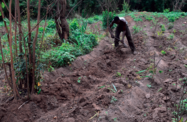Cocoa revenues are set to grow strongly in Nigeria, the world’s fourth-largest producer, thanks to efforts to improve productivity, and higher prices on international markets.
Nigeria’s cocoa production will rise by 10% in the 2013/14 season, boosted by higher prices and the planting of more disease-resistant strains of beans, Robo Adhuze, a spokesman for the Cocoa Association of Nigeria (CAN), told international press on January 24. Nigeria ranks behind Cote d’Ivoire, Ghana and Indonesia in cocoa production, according to the International Cocoa Organisation (ICO).
The CAN is still putting together data for this season, which has two stages – the main harvest running from September to March and a second, smaller crop from June to August, though periods can vary depending on the weather.
Annual output has been around 200,000-250,000 tonnes in recent years, rising to 270,000 in 2012/13, according to the CAN. The industry peaked in the early 1970s, when output reached 300,000 tonnes per year, ranking Nigeria second in the world at that time, behind Brazil. It experienced a decline to 90,000 tonnes in 1999, as farmers replaced cocoa plantations with other crops, but the segment has revived since then, thanks to plantings in the middle of the last decade, according to Adhuze.
In June, the agriculture and natural resources minister, Akinwunmi Adesina, reiterated the government’s plans to double output to 500,000 tonnes by 2015.
The government has been looking to spur activity in several key agricultural sectors – ranging from cassava to oil palm, as well as cocoa – with a host of initiatives to strengthen yields, revive dormant land, improve efficiency and enhance infrastructure. For cocoa, this has meant the Cocoa Research Institute of Nigeria (CRIN) has been distributing high-yield, disease-resistant beans which mature in around 18 months – considerably quicker than the 4-5 year maturity of traditional beans. The new varieties yield 1.5 tonnes of cocoa per ha on average, three times more than the older crop, Adesina has said.
CRIN is also working to boost productivity by training farmers in harvest techniques, crop spacing, weeding, pest control and the use of fertilisers.
Higher prices on global markets
While Nigeria works to improve productivity, rising global prices are also having a demand-pull effect on output.
Data from the ICO show global average prices rose 17% in 2013, partly due to the expectation that dry weather in West Africa would affect yields. Farm-gate prices for Nigerian beans surged by 40% to N420,000 ($2527) per tonne, up from N300,000 ($1805), in the year to January 23, according to the CAN.
International cocoa prices rose to a two-and-a-half-year high on January 27 as demand continued to outstrip supply and inventories fell, the international press reported. In the week before, US stockpiles of cocoa beans declined 3.3%, while the price of cocoa for delivery in March increased by 3.5% ($97) to $2889 per tonne on the ICE Futures US exchange, the highest price since September 2011 and the second 3.5% rise in three trading sessions. The price of cocoa butter – used in chocolate manufacturing – also rose.
Singapore-based Olam International, one of the world’s largest cocoa traders, expects a global shortfall of 185,000 tonnes between supply and demand for the year ending September 2014, as consumption rises by 3.5%. Output is already slowing in West Africa as the harvest – which has been affected by rainfall - comes to an end. Continuing rising demand for chocolate in emerging markets may lead to a sustained deficit, pushing prices further upwards, analysts suggest.
Catching up with regional leaders
Nigeria’s cocoa farmers should be well-placed to take advantage of these favourable market conditions, particularly with the recent drive to increase productivity – which is already seeing yields rise. If all goes according to plan, the recovery seen over the past decade and a half should accelerate.
But as CAN’s Adhuze points out, even if it meets its production goals, Nigeria still lags behind the region’s leaders in cocoa output – Cote d’Ivoire, which produces around 1.4m tonnes a year, and Ghana, which averages 900,000-950,000 tonnes, and saw a spike to 1.1m in 2011/12. The association argues that these countries have been able to outperform Nigeria partly due to clearer government policy towards the sector, including robust support of it.
With the Nigerian government now increasingly rolling out measures and incentives to improve agricultural production and development across the board, cocoa is well-poised to benefit. This should also include ensuring that the sector can remain competitive even if prices ease in the longer term.
Follow Oxford Business Group on Facebook, Google+ and Twitter for all the latest Economic News Updates. Or register to receive updates via email.

